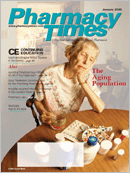Publication
Article
Pharmacy Times
Options for Nail Fungus Treatment
Author(s):
Onychomycosis, or nail fungus, isa common dermatologic condition,occurring when fungi infectone or more of the nails. It is estimatedthat, by the age of 70, up to 50% of individualswill have been infected. Onychomycosisis most often seen in adults,becoming increasingly common withadvancing age. While onychomycosis isamong the most common fungal infectionsfound in the body, it can be difficultto treat and is prone to recurrence.
Fungal nail infections are unsightly, canbe painful, and may cause permanentnail damage. Far more serious complicationscan occur, however, particularly inpeople with diabetes, peripheral vasculardisease, or weakened immune systems.In such cases, a minor injury or infectioncan lead to serious complications suchas foot ulcers. For these reasons, treatmentof the infected nail is important.Symptoms include brittleness, discoloration,thickening of the nail, distortionof the nail's shape, crumbling or raggednails, dullness, loss of luster or shine, orloosening or detachment of the nail.
Types of Onychomycosis
Onychomycosis is generally classifiedinto 4 subtypes. They are:
- Distal subungual: The most commonsubtype, usually presenting as a yellowor white patch of discoloration at thedistal end of the nail.
- White superficial: Fungi invade thesuperficial layer of the nail plate andcause white spots to appear.
- Candidal: Often occurs in nails previouslydamaged by infection or trauma;particularly common in patients withchronic mucotaneous candidiasis.
- Proximal subungual: The least commonform; usually seen in immunocompromisedpatients.
Treatment of Nail Fungus
Several approaches are accepted fortreating onychomycosis, although someare safer and more cost-effective thanothers. Systemic treatments are frequentlyused today but pose a risk ofliver toxicity and other significant sideeffects. Serious drug interactions mayoccur with the use of systemic antifungaltreatments, and full disclosure of all currentmedications is vital. Most systemicmedications can also be made into topicalcompounds. Commonly used systemictreatments include:
- Griseofulvin: Inhibits fungal cell wallsynthesis and DNA production.Possible side effects include rash, gastrointestinal(GI) symptoms, joint pain,peripheral neuropathy, and, occasionally,memory loss.
- Itraconazole: May be used continuouslyor as part of a pulse dose therapy.Potential side effects include rash,headache, GI symptoms, dry skin,weakness, hypertension, or dizziness.Liver function should be monitoredcarefully.
- Terbinafine: Inhibits ergosterol production.Side effects may include headache,rash, GI symptoms, and changesin taste.
- Fluconazole: Considered an off-labeluse but has proven effective in somecases with pulse-dose therapy. Liver enzymesshould be monitored. Immunocompromisedpatients have a greaterrisk of developing side effects, such asGI symptoms, headaches, and pruritis.Significant drug interactions may occurwith drugs such as terbinafine, theophylline,coumadin, cyclosporine, andoral hypoglycemics.
Nonsystemic Treatments andCompounded Medications
For many patients, systemic therapy iscontraindicated, and a topical preparationmay be more appropriate. Currently,one preparation is commercially available,but other options are availablethrough a compounding pharmacy.
Ciclopirox is available under the tradename Penlac. It is used topically oncedaily for up to a year, and its side effectsare usually minimal.
Compounded preparations provide avaluable resource for the treatment ofonychomycosis. A host of options maybe considered, as any of the commerciallyavailable systemic products mentionedabove may be prepared as a topicalagent by an experienced compoundingpharmacist. Other agents may alsobe added to enhance the effectivenessof the drug. Some physicians combinetopical treatment with oral pulse therapyfor maximum effectiveness.
Compounded medications may beless costly than systemic treatments.For this reason, as well as the lowerchance of potentially harmful sideeffects and the ability to individualizetreatment, compounded medicationsfor onychomycosis should be consideredas a first-line treatment for nailfungus.
Ms. Fields is with the InternationalJournal of PharmaceuticalCompounding and is a pharmacytechnician at Innovative PharmacyServices in Edmond, Okla.
For More InformationThe International Journal ofPharmaceutical Compounding(IJPC) is a bimonthly scientific andprofessional journal emphasizinghigh-quality pharmaceutical compounding.The journal covers topicsrelevant and necessary toempower pharmacists to meet theneeds of today's patients. Formore information, or to subscribeto IJPC, visit www.ijpc.com, or call888-588-4572.







